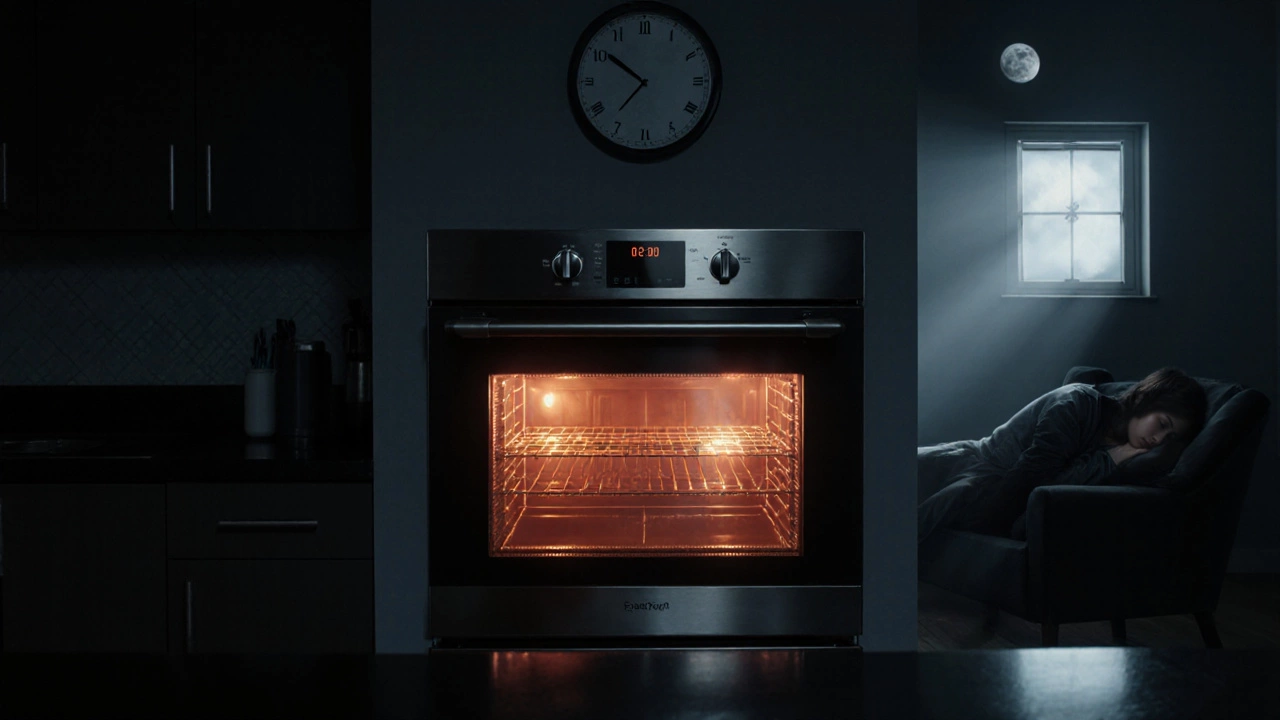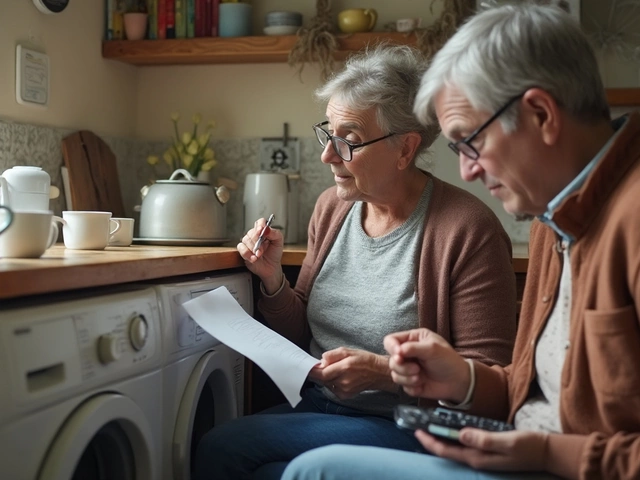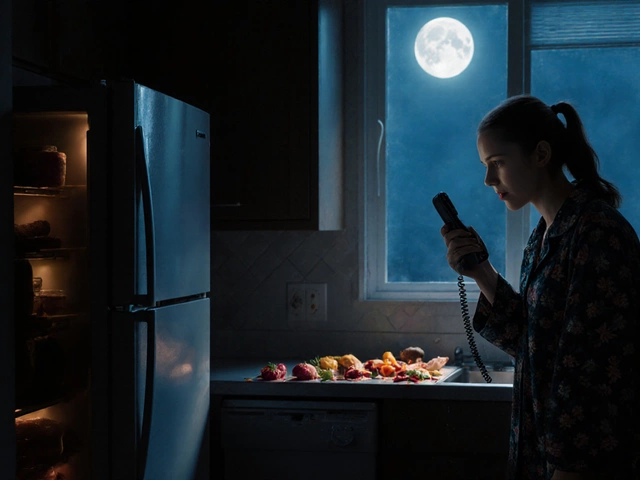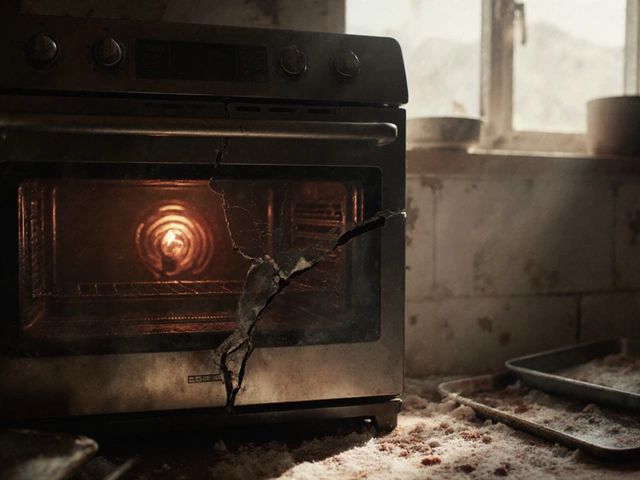Electric Oven Cost Calculator
Calculate the energy cost and risk of leaving your electric oven on overnight. Based on your oven's wattage, hours left on, and electricity rate, this tool shows you the financial impact and safety considerations.
Ever wonder if it’s okay to fall asleep with the oven still running? While the thought of waking up to a perfectly cooked roast is tempting, leaving an Electric oven is a kitchen appliance that uses electricity to generate heat for cooking food on all night can bring a mix of safety hazards, hidden costs, and premature wear.
How an Electric Oven Generates Heat
Understanding the risk starts with a quick look at how the appliance works. An electric oven relies on a few key components:
- Heating element is a resistive wire that converts electrical energy into heat. When the oven is switched on, the element glows red and emits radiant heat.
- The Thermostat is a temperature sensor that signals the oven to turn the heating element on or off to maintain the set temperature. Modern units often use electronic temperature probes instead of mechanical bimetal strips.
- A Circuit breaker is a safety device in the home’s electrical panel that trips if current exceeds safe limits. It protects both the oven and the house from overloads.
- Many ovens also feature a Safety switch is an internal mechanism that cuts power if the oven door is opened while heating, preventing accidental burns.
These parts work together to keep the oven at a stable temperature. When you leave the oven on, they stay active for hours longer than intended, and that’s where trouble begins.
Fire Risk: The Most Dangerous Outcome
electric oven safety concerns center around fire. While most ovens are built to handle continuous operation, a few scenarios can turn a sleeping night into a nightmare:
- Overheating of the heating element. If food debris or grease builds up on the element, it can reach temperatures well above the set point, igniting the residue.
- Faulty thermostat. A malfunctioning thermostat may lose its ability to shut off the element, causing the oven to run indefinitely.
- Electrical fault. Frayed wiring or a loose connection can spark, especially if the circuit breaker fails to trip for any reason.
Australian standards (AS/NZS 60335) require ovens to have built‑in fire‑safety features, but no system is foolproof. The probability of a fire is low-statistics from the Australian Fire Safety Association show that only about 2% of residential fires involve an oven-but the consequences can be severe, ranging from property loss to injuries.
Energy Waste: What Your Bills Look Like
Leaving the oven on for eight hours can add a surprising amount to your electricity bill. Consider a typical 3kW heating element running at full power for 8hours:
- Power consumption = 3kW × 8h = 24kWh.
- Average Queensland residential electricity price in 2025 is about AUD0.35 per kWh.
- Cost = 24kWh × AUD0.35 ≈ AUD8.40 per night.
Do that twice a week, and you’re looking at over AUD70 a month for a habit you barely notice. That extra energy also contributes to higher carbon emissions, which is something environmentally‑conscious households try to avoid.
Component Wear: Shortening Your Oven’s Life
Continuous heating stresses the oven’s core parts:
- The heating element’s coil ages faster under constant high temperatures, leading to premature burnout.
- The thermostat’s sensors drift when exposed to prolonged heat cycles, reducing temperature accuracy.
- Electrical contacts within the control board can oxidize, causing intermittent failures that eventually need professional Appliance repair is the service of diagnosing and fixing home appliances.
In the long run, the small nightly habit may cost you a full‑size oven replacement, which can run between AUD1,200 and AUD2,500 for a mid‑range model.
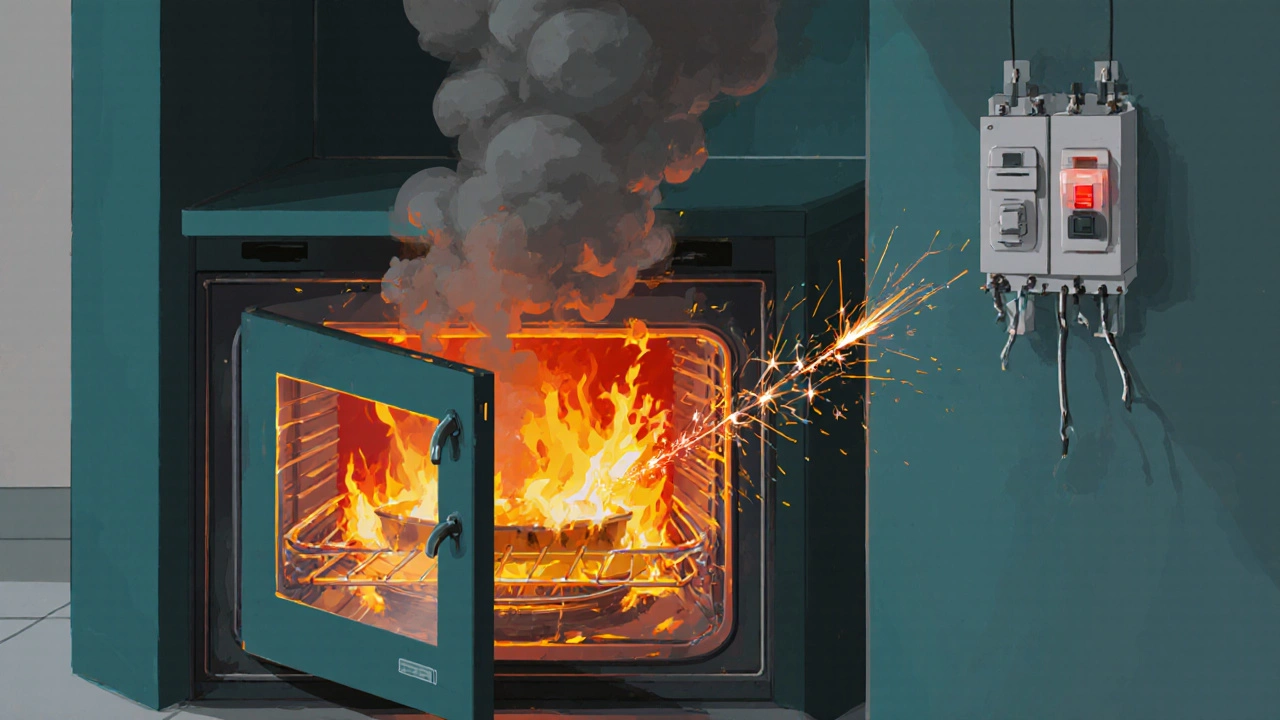
Built‑In Safety Mechanisms: What Works and What Doesn’t
Modern ovens come equipped with a few safeguards intended to stop a runaway scenario:
- Thermal fuse. A one‑time use component that blows if the oven exceeds a set temperature, cutting power to the element.
- Auto‑shutoff timer. Some models let you set a maximum run time (e.g., 2hours). After the timer expires, the oven powers down.
- Delay start and keep‑warm features. These deliberately limit heating, but they’re not designed to replace human oversight.
These safeguards are helpful, yet they’re not guaranteed. An aging thermal fuse can become stuck, and a timer won’t protect you if you forget to turn the oven off and the timer is disabled.
What to Do If You Realise the Oven Was Left On
First, stay calm. Immediate actions can prevent escalation:
- Turn it off. Use the oven’s power knob or, if you’re unsure it’s working, switch off the dedicated circuit at the breaker panel.
- Vent the kitchen. Open windows to disperse any lingering heat and potential fumes from burnt food.
- Check for smoke or fire. Look at the interior for any visible flames or thick smoke. If you see fire, evacuate and call 000 immediately.
- Inspect the heating element. Once the oven cools, look for discoloration or carbon buildup that could indicate a hotspot.
- Call a professional. If the thermostat, thermal fuse, or wiring shows signs of damage, schedule a qualified Appliance repair visit.
After the incident, reset any affected safety devices-many thermal fuses are replace‑only, so a technician’s help is required.
Preventive Tips: Keep Nighttime Oven Mishaps at Bay
- Always double‑check the control panel. Make it a habit to glance at the oven knob before leaving the kitchen.
- Use the auto‑shutoff timer. If your model offers one, set it to the shortest reasonable time for your recipe.
- Keep a fire‑extinguisher nearby. A ClassK extinguisher is designed for kitchen fires involving oil or grease.
- Install a Fire alarm is a device that detects smoke or heat and sounds an alert with a heat sensor specifically for the cooking area.
- Maintain the oven. Clean the heating element and interior regularly to avoid grease buildup.
- Consider a smart plug. A Wi‑Fi enabled plug lets you turn the oven off remotely from your phone-just be sure the plug is rated for the oven’s amperage.
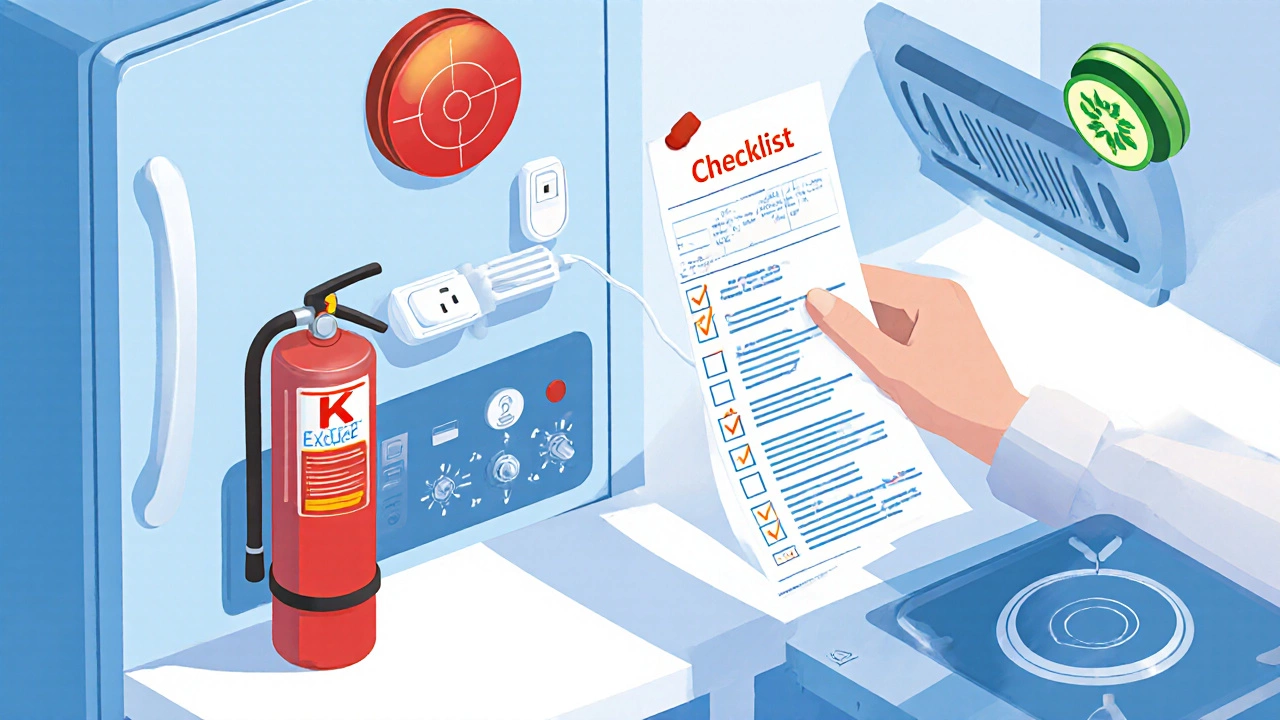
Cost Comparison: Leaving On vs Turning Off
| Impact | Leave On (8 hrs) | Turn Off |
|---|---|---|
| Electricity cost (AUD) | ~8.40 | ~0.00 |
| Fire risk (probability) | Low‑to‑moderate (depends on condition) | Negligible |
| Component wear (years saved) | ~0.2yr per night | 0yr |
| Potential repair cost (AUD) | Variable - up to 300 for coil/fuse replacement | None (assuming proper maintenance) |
The table makes it clear: the extra cost and risk rarely justify the convenience of an unattended oven.
When to Call a Professional
If you notice any of the following, don’t try a DIY fix-schedule a qualified technician:
- Repeatedly tripping of the Circuit breaker is a protective device that shuts off electricity when current exceeds safe levels when the oven is on.
- Odor of burning plastic or metal even after the oven is turned off.
- Visible scorch marks on the interior walls or heating element.
- Inconsistent temperature readings - food cooks unevenly despite correct settings.
A professional will test the thermostat, replace a blown thermal fuse, and recalibrate the control board, ensuring your oven runs safely for years to come.
Quick Checklist Before Bed
- Did you finish cooking? If not, use the timer or turn the oven off.
- Is the oven door fully closed?
- Did you set an auto‑shutoff timer?
- Is the kitchen vent fan running to clear any residual heat?
- Do you have a fire extinguisher within arm’s reach?
Run through these five points and you’ll sleep soundly knowing the oven isn’t a hidden hazard.
Frequently Asked Questions
Can I leave my electric oven on while I sleep?
It’s not recommended. Even though modern ovens have safety features, the fire risk, energy waste, and wear on components make it unsafe to leave the oven unattended for hours.
How much electricity does an oven use if left on all night?
A typical 3kW element running for eight hours consumes about 24kWh, costing roughly AUD8.40 at current Queensland rates.
What safety devices are built into electric ovens?
Most ovens have a thermal fuse, an auto‑shutoff timer, a safety switch that cuts power when the door opens, and sometimes a heat sensor linked to the fire alarm system.
Will my home’s circuit breaker trip if the oven overheats?
Only if the current exceeds the breaker’s rating. A faulty thermostat can cause the element to stay on without raising current enough to trip the breaker, so a trip isn’t guaranteed.
What should I do if I smell burning after leaving the oven on?
First, turn the oven off and ventilate the kitchen. If smoke persists or you see flames, evacuate and call emergency services. Afterwards, have a qualified technician inspect the oven.
Is a smart plug safe for controlling an electric oven?
Only if the plug is rated for the oven’s amperage (usually 13A in Australia). An undersized plug can overheat and become a fire hazard.
